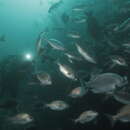en
names in breadcrumbs


Die hottentot (Pachymetopon blochii) is vis wat endemies aan Suid-Afrika is. Die vis kom voor van die kus van Namibië tot by Tafelbaai, Valsbaai en die Agulhasbank. Dit kan ook tot in Algoabaai voorkom. In Engels staan die vis bekend as die hottentot seabream.
Die vis is vet, silwergrys met donker vinne, 'n blougrys pens en 'n klein bek. Die vis word 54 cm lank en tot 3 kg swaar.
Dit kom voor in vlak rotsagtige gebiede en kelpbeddings tot op 'n diepte van 55 m. Die vis is 'n omnivoor.
Die hottentot (Pachymetopon blochii) is vis wat endemies aan Suid-Afrika is. Die vis kom voor van die kus van Namibië tot by Tafelbaai, Valsbaai en die Agulhasbank. Dit kan ook tot in Algoabaai voorkom. In Engels staan die vis bekend as die hottentot seabream.
Pachymetopon blochii és un peix teleosti de la família dels espàrids i de l'ordre dels perciformes.[2][3]
Pot arribar als 46 cm de llargària total i als 1.700 g de pes.[4]
Es troba a les costes del sud-est de l'Atlàntic: des d'Angola fins a la costa oest de Sud-àfrica.[4]
Pachymetopon blochii, the hottentot seabream or hottentot, is a species of sea bream in the family Sparidae, native to the southwestern coast of Africa.
Pachymetopon blochii has a bronzy grey color, with darker fins. The small mouth contains five rows of incisors in both upper and lower jaw, but no molars.[2] Adults are commonly around 25 cm in length at the age of maturity, but may reach up to 54 cm, with a maximum recorded weight of 2.67 kg.[1]
The species occurs in the southeastern Atlantic, from Angola to Cape Agulhas at the southern tip of South Africa.[3] Vagrants have been recorded as far east as the mouth of the Tsitsikamma River.[1]
Pachymetopon blochii inhabits kelp beds on shallow rocky reefs, as well as blinders, subtidal reefs and offshore pinnacles in deeper waters (up to 55 m). Juveniles are restricted to the kelp beds.[1]
The species is a generalist and feeds on seaweeds, algae, crustaceans, worms, molluscs, sea urchins, and occasionally small fish. It may spawn all year round, with peaks in summer and winter.[1] Individuals generally live to an age of about 12 years,[2] but may exceptionally reach an age of up to 21 years. Generation length is about 9 years.[1]
Pachymetopon blochii is a frequent host of the parasitic isopod Anilocra capensis.[4]
Pachymetopon blochii is an important species in a variety of smaller-scale fisheries (artisanal linefishery, recreational shore and ski-boat fishery) and occurs as bycatch in gill-net fishery. However, it appears not to be exploited to an extent that is damaging stocks, and is common in a number of protected areas in its range. It is therefore classified as Least Concern by the IUCN.[1]
Pachymetopon blochii, the hottentot seabream or hottentot, is a species of sea bream in the family Sparidae, native to the southwestern coast of Africa.
Pachymetopon blochii es una especie de peces de la familia Sparidae en el orden de los Perciformes.
Los machos pueden llegar alcanzar los 46 cm de longitud total y los 1.700 g de peso.[2]
Se encuentra en las costas del sureste del Atlántico: desde Angola hasta la costa oeste de Sudáfrica.
Pachymetopon blochii Pachymetopon generoko animalia da. Arrainen barruko Sparidae familian sailkatzen da.
Pachymetopon blochii Pachymetopon generoko animalia da. Arrainen barruko Sparidae familian sailkatzen da.
Pachymetopon blochii is een straalvinnige vissensoort uit de familie van zeebrasems (Sparidae).[1] De wetenschappelijke naam van de soort is voor het eerst geldig gepubliceerd in 1830 door Valenciennes.
Bronnen, noten en/of referenties布氏切齒鯛為輻鰭魚綱鱸形目鱸亞目鯛科的其中一種,分布於東南大西洋區,從安哥拉至南非西部海域,棲息深度20-50公尺,體長可達46公分,棲息在水淺、岩石底質海域,屬雜食性,以藻類、甲殼類、棘皮動物、蠕蟲等為食,可做為食用魚及遊釣魚。